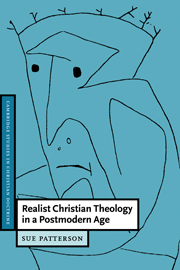Book contents
- Frontmatter
- Contents
- Acknowledgements
- Introduction
- 1 The task of theological realism
- 2 The dilemma of postliberal theology
- 3 Interpreting the truth
- 4 The anatomy of language-riddenness
- 5 The nature of theistic realism
- 6 Becoming persons
- 7 Becoming the Church
- Conclusion
- Select bibliography
- Index of names
- Index of subjects
Introduction
Published online by Cambridge University Press: 02 December 2009
- Frontmatter
- Contents
- Acknowledgements
- Introduction
- 1 The task of theological realism
- 2 The dilemma of postliberal theology
- 3 Interpreting the truth
- 4 The anatomy of language-riddenness
- 5 The nature of theistic realism
- 6 Becoming persons
- 7 Becoming the Church
- Conclusion
- Select bibliography
- Index of names
- Index of subjects
Summary
This inquiry's twin concerns are the nature of theology and the nature of reality, where the issue that links them both is the role of language – not the content of language as in theological language, although that is part of it; rather, language as an entity in itself. The scope of the inquiry is the combined context of contemporary realist, postliberal and liberal revisionist theology. It straddles all these schools to a greater or lesser extent in that it arises out of the awareness that, while their various preoccupations and insights are different and potentially complementary, their shortcomings are essentially similar.
The nature of theology
Contemporary theological realists (such as T. F. Torrance) tend to operate with what might be termed a linguistic-window-on-reality model, however much the view from that window is acknowledged to be partial, theory-laden and in need of progressive revisions. While this window on reality is clouded by the limitations and distortions of human concepts, it becomes clearer if not transparent in the search for the truth as the truth gives itself to us to be known. Theological realists accordingly regard theology as having a scientific character in that, like scientific observation and theory-building, it is governed by its object. The being of God reflected in contingent creaturely being has an intrinsic rationality which the human knower comes to know in the same way that he or she comes to know worldly reality – that is, by ‘grasping it in its depths’ through participating in the given (revealed) structures of its being. This approach, therefore, asserts a universal rationality which is in the first place divine and in the second place, contingently, cosmic or worldly.
- Type
- Chapter
- Information
- Realist Christian Theology in a Postmodern Age , pp. 1 - 11Publisher: Cambridge University PressPrint publication year: 1999

